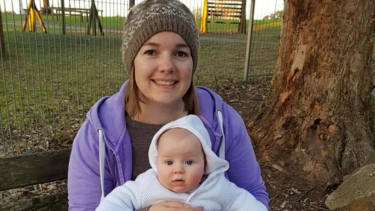Heather Dunn hadn't intended on being eight months late for her scheduled pap smear but life, and life with a two year-old toddler, got in the way.
Ms Dunn's GP knew immediately that something wasn't right.
Heather Dunn, 33, was diagnosed with cervical cancer four years ago.
A biopsy would confirm that Ms Dunn had cervical cancer.
Heather Dunn, 33, was diagnosed with cervical cancer four years ago.
"It was mindblowing and devastating," Ms Dunn, 33, says of the diagnosis. Her symptoms, slight bleeding after sexual intercourse, were nothing she'd thought to worry about.
What followed was major surgery, followed by regular pap smears and colposcopy procedures.
Four years on from the diagnosis Ms Dunn has since had another baby and says she is one of the lucky ones. But she now lives with what she describes as "crippling" anxiety around her health.
"The worry is always there, and I live with that every day," she says.
According to a new survey from the Australian Cervical Cancer Foundation (ACCF), more than a quarter of Australian women say they are reticent to book the Cervical Screening Test (CST, previously known as the Pap or smear test), with embarrassment or awkwardness around the procedure a major factor. This is despite 80 per cent of women believing keeping up with the test is important.
On Thursday the ACCF launches its CerFIX2035 campaign to raise awareness of the importance of the test for women aged 25 to 74.
Cervical cancer is on track to become a rare disease in Australia, largely credited to its world-leading vaccination program for school children and the introduction of the pap smear program in 1991.
A recent study in The Lancet Public Health, predicted that the disease will be eradicated by 2035 in Australia if vaccination and screening is continued at current rates.
But it is estimated that 951 women will be diagnosed and 256 will die from cervical cancer in 2019.
In December 2017 the pap smear was phased out in favour of the CST, an HPV test (Human Papilloma Virus) which looks for the presence of the HPV virus, rather than pre-cancerous cells. HPV is present in about 99 per cent of cervical cancer cases. The new test is more accurate and can detect problems earlier than the pap smear. It is offered every five years instead of bi-annually like the pap smear.
Dr Unine Herbst, Gynaecological Oncology Surgeon at Sydney's Westmead Hospital, is optimistic that the 2035 goal will be reached. However she says there still remains the need for an education process around the change in the screening process and its importance.
"People need the right information about the importance of undergoing the cervical screening, " she says, "and they need to be asked every time when seeking health care if they are eligible for [the test] and have you had it done," she says.
Dr Herbst is wary of people using "Dr Google" instead of seeking proper medical advice and agrees that embarrassment can be a reason why women are putting off getting the test.
"We need to address the concerns and embarrassment patients are experiencing – it's normal, every woman has a different vulva, a vagina, a cervix there is no designer vagina or cervix. It might be uncomfortable for a few seconds but then you have reassurance for at least five years that you are at a low risk for developing abnormalities," she says.
Joe Tooma, CEO of the Australian Cervical Cancer Foundation, says that while great gains have been in driving down cases of cervical cancer these misunderstandings must be addressed.
"To make [eradication of cervical cancer by 2035] a reality, we know we must ensure we maintain high rates of HPV vaccination among eligible school-age male and females offered via the National Immunisation Program whilst concurrently increasing current Cervical Screening Test participation rates from 50 per cent to more than 70 per cent," he says.
"It's imperative therefore that we not only act but react to the new research. That is why we have launched cerFIX2035 today with a big ambition – to see Australia become the first country to officially eradicate cervical cancer by 2035. Eradication is within our grasp – that is a truly exciting and achievable proposition."
Source: Read Full Article

